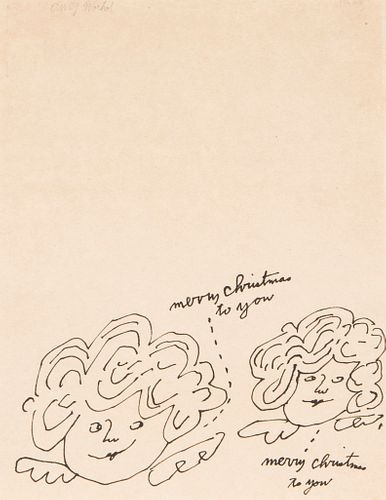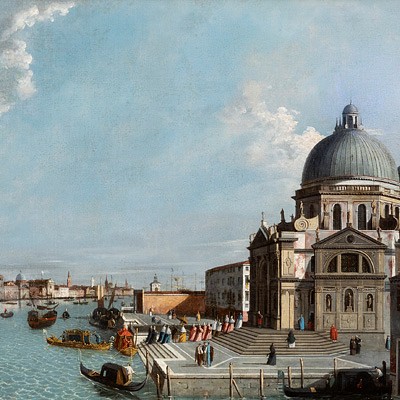ANDY WARHOL (Pittsburgh, USA, 1928 – New York, USA, 1987). "Two Christmas Fairies", ca. 1954. Ink on paper. Signed in the upper left corner. Prese
Lot 65
About Seller
Setdart Auction House
Carrer Aragó 346
Barcelona
Spain
Setdart Subastas was born in 2004 and is currently the first online art auction in Spain with solidity, prestige and reliability guaranteed by our more than 60,000 users. Setdart has a young, dynamic and enterprising team ready to successfully manage the purchase and sale of art works through custom...Read more
Categories
Estimate:
EUR€15,000 - EUR€16,000
$16,129.03 - $17,204.30
Absentee vs Live bid
Two ways to bid:
- Leave a max absentee bid and the platform will bid on your behalf up to your maximum bid during the live auction.
- Bid live during the auction and your bids will be submitted real-time to the auctioneer.
Bid Increments
| Price | Bid Increment |
|---|---|
| EUR€0 | EUR€10 |
| EUR€200 | EUR€25 |
| EUR€500 | EUR€50 |
| EUR€1,000 | EUR€100 |
| EUR€3,000 | EUR€200 |
| EUR€5,000 | EUR€500 |
| EUR€10,000 | EUR€1,000 |
| EUR€20,000 | EUR€2,000 |
| EUR€50,000 | EUR€5,000 |
About Auction
By Setdart Auction House
May 18, 2021
Set Reminder
2021-05-18 09:30:00
2021-05-18 09:30:00
America/New_York
Bidsquare
Bidsquare : Classics XIX and XX
https://www.bidsquare.com/auctions/setdart-auction-house/classics-xix-and-xx-6961
The next 18th May there will be a 19th and 20th Century Classics Auction at Setdart.com There will be a select repertoire of important artists such as Carlos Cruz Diez, Luis Feito, Joan Miró, Fernando Botero, Josep Llimona, Salvador Dalí among others. Setdart Auction House sofia@setdart.com
The next 18th May there will be a 19th and 20th Century Classics Auction at Setdart.com There will be a select repertoire of important artists such as Carlos Cruz Diez, Luis Feito, Joan Miró, Fernando Botero, Josep Llimona, Salvador Dalí among others. Setdart Auction House sofia@setdart.com
- Lot Description
ANDY WARHOL (Pittsburgh, USA, 1928 – New York, USA, 1987). "Two Christmas Fairies", ca. 1954. Ink on paper. Signed in the upper left corner. Presents stamp of the Estate of Andy Warhol and Andy Warhol Founation of Visual Arts num. 274,014. Attach certificate of provenance. Measurements: 30x 22 cm; 48 x 40 cm (frame). During the 1950s, Andy Warhol, the world's leading exponent of Pop art, devoted himself to the illustration of children's books. Specifically, one of the most characteristic contributions of the American artist to the field of illustration was the series of offset lithographs starring cherubs and fairies that the artist himself later hand-colored using the watercolor technique. These compositions conceal a certain naïve aesthetic, although the flat colors used, as well as the completely defined silhouettes, allude to his distinguished figure as a commercial Pop art artist. Thus, the present work, "Two Christmas Fairies" would be, therefore, only the beginning of Andy Warhol's promising career that would lead him to worldwide success. Considered at the time a guru of modernity, Warhol was one of the most influential artists of the 20th century. The son of Slovakian immigrants, he began his art studies at the Carnegie Institute of Technology between 1945 and 1949. In the latter year, already established in New York, he began his career as an advertising cartoonist for various magazines such as Vogue, Harper's Bazaar, Seventeen and The New Yorker. At the same time he painted canvases whose subject matter was based on some element or image from the everyday environment, advertising or comics. Soon he began to exhibit in various galleries. He progressively eliminated from his works any expressionist trait until he reduced the work to a serial repetition of a popular element from mass culture, the world of consumerism or the media. This evolution reached its maximum level of depersonalization in 1962, when he began to use a mechanical silkscreen printing process as a working method, through which he systematically reproduced myths of contemporary society, the most representative examples of which are the series dedicated to Marilyn Monroe, Elvis Presley, Elizabeth Taylor or Mao Tse-tung, as well as his famous treatment of Campbell's soup cans, all of them works produced during the fruitful decade of the 1960s. This appropriationism, a constant in the works of the proponents of pop art, extended to works of art of a universal nature. By means of mass reproduction, he managed to strip the media fetishes he used of their usual referents and turn them into stereotyped icons with a merely decorative purpose. In 1963 he created the Factory, a workshop in which numerous figures from New York's underground culture gathered around him. The frivolity and extravagance that marked his way of life eventually established a coherent line between his work and his life's trajectory. He is currently represented in the most important contemporary art museums in the world, such as the MoMA, the Metropolitan and the Guggenheim in New York, the Fukoka Museum in Japan, the Kunstmuseum in Basel, the National Art Museum of the 21st century in Rome, the MUMOK in Vienna, the SMAK in Ghent and the Tate Gallery in London, as well as in the museums that bear his name in Pittsburgh and Medzilaborce (Slovakia).Attach certificate of provenance.
Condition
- Shipping Info
-
In-House Shipping
-
- Buyer's Premium



 EUR
EUR CAD
CAD AUD
AUD GBP
GBP MXN
MXN HKD
HKD CNY
CNY MYR
MYR SEK
SEK SGD
SGD CHF
CHF THB
THB
















